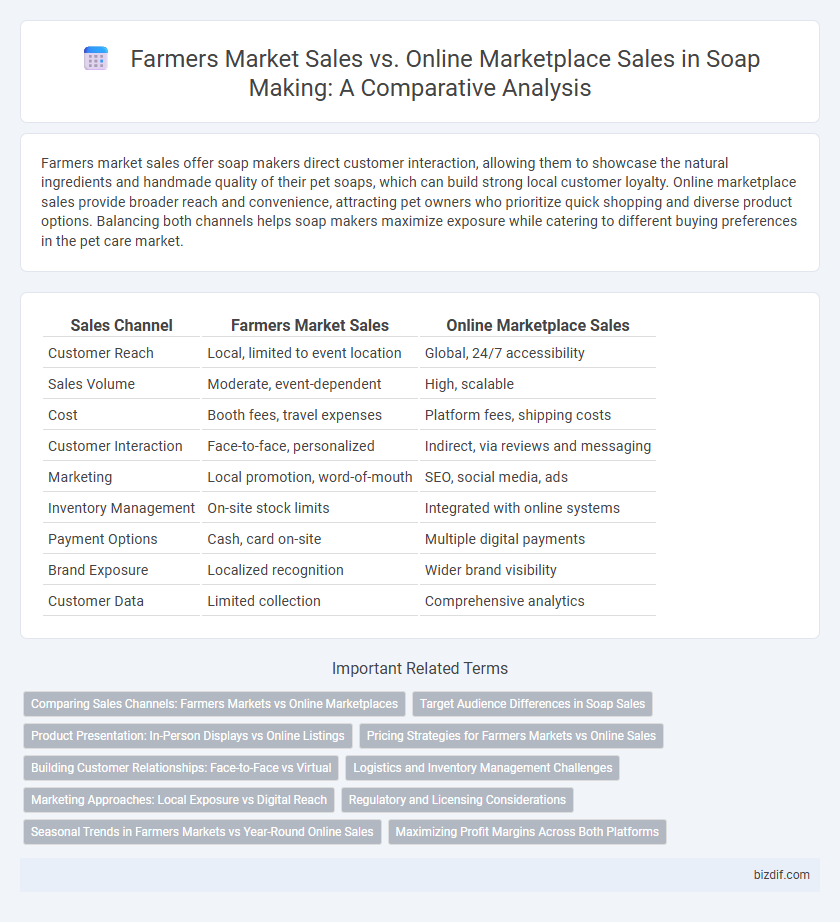Farmers market sales offer soap makers direct customer interaction, allowing them to showcase the natural ingredients and handmade quality of their pet soaps, which can build strong local customer loyalty. Online marketplace sales provide broader reach and convenience, attracting pet owners who prioritize quick shopping and diverse product options. Balancing both channels helps soap makers maximize exposure while catering to different buying preferences in the pet care market.
Table of Comparison
| Sales Channel | Farmers Market Sales | Online Marketplace Sales |
|---|---|---|
| Customer Reach | Local, limited to event location | Global, 24/7 accessibility |
| Sales Volume | Moderate, event-dependent | High, scalable |
| Cost | Booth fees, travel expenses | Platform fees, shipping costs |
| Customer Interaction | Face-to-face, personalized | Indirect, via reviews and messaging |
| Marketing | Local promotion, word-of-mouth | SEO, social media, ads |
| Inventory Management | On-site stock limits | Integrated with online systems |
| Payment Options | Cash, card on-site | Multiple digital payments |
| Brand Exposure | Localized recognition | Wider brand visibility |
| Customer Data | Limited collection | Comprehensive analytics |
Comparing Sales Channels: Farmers Markets vs Online Marketplaces
Farmers markets offer soap makers direct customer interaction, enabling personalized sales and immediate feedback, which can boost brand loyalty and local market presence. Online marketplaces provide broader reach, 24/7 availability, and access to diverse demographics, increasing potential sales volume but with higher competition and fees. Balancing farmers market sales with online marketplace strategies optimizes revenue by combining tactile, community-driven sales with scalable digital exposure.
Target Audience Differences in Soap Sales
Farmers market sales in soap making primarily attract local customers seeking artisanal, handmade products with a personal touch, often favoring natural ingredients and unique scents. Online marketplace sales target a broader, more diverse audience looking for convenience, competitive prices, and access to a wider variety of soap types, including specialty and organic options. Understanding these target audience differences helps soap makers tailor marketing strategies, product offerings, and packaging to maximize engagement and sales on each platform.
Product Presentation: In-Person Displays vs Online Listings
Farmers market sales benefit from tangible, sensory product presentations where customers can see, touch, and smell soaps, fostering immediate trust and emotional connection. In-person displays allow artisans to create visually appealing setups with natural lighting and personalized packaging that enhance the soap's artisanal appeal. Online marketplace sales rely heavily on high-quality images, detailed product descriptions, and customer reviews to convey the soap's texture, fragrance, and benefits without physical interaction.
Pricing Strategies for Farmers Markets vs Online Sales
Farmers market pricing strategies often emphasize competitive pricing with a focus on value perception and direct customer interaction, allowing artisans to adjust prices based on immediate feedback and local demand. Online marketplace sales require strategic pricing that considers platform fees, shipping costs, and broader competition, often necessitating slightly higher prices to maintain profit margins. Effective pricing for both channels involves balancing affordability with quality presentation to attract target customers while covering operational costs.
Building Customer Relationships: Face-to-Face vs Virtual
Farmers market sales foster direct, face-to-face customer interactions, allowing soap makers to build trust through personal storytelling and immediate feedback. Online marketplace sales rely on virtual communication channels, emphasizing detailed product descriptions and digital reviews to establish credibility. Both approaches enhance customer relationships by adapting engagement strategies to their distinct environments, maximizing customer loyalty.
Logistics and Inventory Management Challenges
Farmers market sales require manual transportation of soap batches, limiting inventory size and increasing setup time, while online marketplace sales demand efficient warehousing and streamlined order fulfillment systems to handle variable demand and shipping logistics. Managing perishability and storage conditions is critical in both channels, but online sales necessitate robust inventory tracking software to synchronize stock levels across multiple platforms. Logistics challenges in farmers markets revolve around local deliveries and immediate customer interaction, contrasting with complex shipping logistics and returns processing inherent in online marketplaces.
Marketing Approaches: Local Exposure vs Digital Reach
Farmers market sales leverage face-to-face marketing, offering local exposure that builds community trust and immediate customer feedback for soap makers. Online marketplace sales utilize digital reach, enabling targeted advertising and global audience access through social media and search engine optimization. Both approaches require tailored marketing strategies to maximize visibility, with local events boosting personal connections and online channels enhancing brand scalability.
Regulatory and Licensing Considerations
Farmers market sales of handmade soap often require compliance with local health department regulations and permits, ensuring products meet safety standards and labeling requirements. Online marketplace sales demand adherence to broader federal regulations, such as FDA guidelines for cosmetic products, along with platform-specific policies regarding ingredient disclosure and shipping restrictions. Understanding these regulatory and licensing considerations is crucial to legally marketing soap across both sales channels and avoiding costly fines or product removals.
Seasonal Trends in Farmers Markets vs Year-Round Online Sales
Farmers market sales of soap exhibit strong seasonal peaks, typically flourishing during spring and summer months when outdoor foot traffic increases and local events draw crowds. In contrast, online marketplace sales maintain consistent year-round demand due to convenient access, expanded reach, and the ability to purchase specialty soaps regardless of season. This seasonal variability in physical markets calls for strategic inventory planning, while online sales benefit from stable revenue streams and ongoing promotion.
Maximizing Profit Margins Across Both Platforms
Farmers market sales offer direct customer interactions and lower overhead costs, enhancing profit margins through personalized service and immediate feedback. Online marketplace sales expand reach to a broader audience with scalable marketing opportunities, though higher platform fees and shipping expenses require strategic pricing. Balancing competitive pricing with unique branding across both platforms maximizes overall profitability in soap making ventures.
Farmers Market Sales vs Online Marketplace Sales Infographic

 bizdif.com
bizdif.com